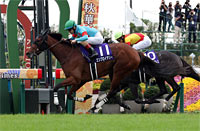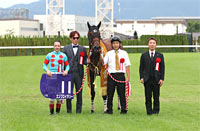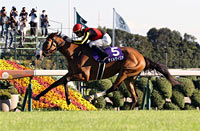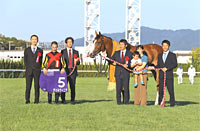Shuka Sho (G1) - Data Analysis
Final hurdle of the Triple Crown for three-year-old fillies that delivers few upsets
In 2021, runners backed by win odds of less than 10 dominated the Top 3 of the Shuka Sho, resulting in a Trifecta payout of only 26,410 yen. In the 18 years since Trifecta bets were introduced in 2004, the Trifecta payout for this race has dipped below 20,000 yen eight times, and below 10,000 yen four times. Conversely, it has only exceeded 100,000 yen three times. The 2008 race produced a massive Trifecta payout of 10,982,020 yen, but highly favored runners generally tend to fare well in this race. Let's now analyze some features shared by successful runners in this race based on results over the last 10 years including the years through 2020, when the race was held at Kyoto Racecourse.
Focus on runners from "Kansai stables" based at Ritto Training Center
Of the 30 Top 3 finishers over the last 10 years, 24 were based at Ritto Training Center. Conversely, runners based at Miho Training Center struggled with a Top 3 ratio of 8.7%. Incidentally, four of the six Top 3 finishers based at Miho Training Center belonged to the Sakae Kunieda stable. [Table 1]
[Table 1] Performance by affiliation (last 10 years)
| Affiliation |
Performance
[1st-2nd-3rd-4th or lower] |
Win ratio |
Top 2 ratio |
Top 3 ratio |
| Miho |
2-4-0-63 |
2.9% |
8.7% |
8.7% |
| Ritto |
8-6-10-82 |
7.5% |
13.2% |
22.6% |
Strong performers last time out have an edge
Of the 30 Top 3 finishers in the last 10 years, 28 had finished in the Top 5 of their previous race. Meanwhile, runners that had finished 6th or lower struggled with a Top 3 ratio of 3.4%. [Table 2]
[Table 2] Performance by finish in previous race (last 10 years)
| Finish in previous race |
Performance
[1st-2nd-3rd-4th or lower] |
Win ratio |
Top 2 ratio |
Top 3 ratio |
| 5th or higher |
10-10-8-89 |
8.5% |
17.1% |
23.9% |
| 6th or lower |
0-0-2-56 |
0% |
0% |
3.4% |
In addition, of the 15 Top 3 finishers in the last five years, 14 had finished in the Top 4 of their previous race. If trends in recent years are anything to go by, we need to discount runners that have finished 5th or lower in their previous race. [Table 3]
[Table 3] Performance by finish in previous race (last five years)
| Finish in previous race |
Performance
[1st-2nd-3rd-4th or lower] |
Win ratio |
Top 2 ratio |
Top 3 ratio |
| 4th or higher |
5-5-4-43 |
8.8% |
17.5% |
24.6% |
| 5th or lower |
0-0-1-28 |
0% |
0% |
3.4% |
Sluggish performance by runners that led the pack last time out
Of the 30 Top 3 finishers over the last 10 years, 23 had been positioned 5th or lower when passing the 4th corner in their previous race. Conversely, runners that had been positioned 4th or higher struggled with a Top 3 ratio of 9.7%. [Table 4]
[Table 4] Performance by position when passing 4th corner in previous race (last 10 years)
| Position when passing 4th corner in previous race |
Performance
[1st-2nd-3rd-4th or lower] |
Win ratio |
Top 2 ratio |
Top 3 ratio |
| 4th or higher |
1-3-3-65 |
1.4% |
5.6% |
9.7% |
| 5th or lower |
9-7-7-80 |
8.7% |
15.5% |
22.3% |
In addition, four of the seven runners that finished in the Top 3 despite being positioned 4th or higher when passing the 4th corner in their previous race, were sired by Deep Impact. We should therefore expect little from runners that were positioned 4th or higher when passing the 4th corner in their previous race and that were sired by a horse other than Deep Impact. [Table 5]
[Table 5] Among runners that had been positioned 4th or higher when passing the 4th corner in the previous race, performance by sire (last 10 years)
| Sire |
Performance
[1st-2nd-3rd-4th or lower] |
Win ratio |
Top 2 ratio |
Top 3 ratio |
| Deep Impact |
1-2-1-10 |
7.1% |
21.4% |
28.6% |
| Sires other than Deep Impact |
0-1-2-55 |
0% |
1.7% |
5.2% |
Favoritism in previous race also a key factor
Looking at performances by runners over the last 10 years in terms of favoritism in the previous race, we find that runners that had been backed as 2nd favorite or higher in that race achieved a relatively strong Top 3 ratio of 33.9%. Conversely, runners that had been backed as 7th favorite or lower struggled with a Top 3 ratio of 3.6%. When checking the details of the previous race, we should concentrate on favoritism in that race. [Table 6]
[Table 6] Performance by favoritism in previous race (last 10 years)
| Favoritism in previous race |
Performance
[1st-2nd-3rd-4th or lower] |
Win ratio |
Top 2 ratio |
Top 3 ratio |
| 2nd favorite or higher |
8-7-4-37 |
14.3% |
26.8% |
33.9% |
| 3rd-6th favorite |
2-3-4-55 |
3.1% |
7.8% |
14.1% |
| 7th favorite or lower |
0-0-2-53 |
0% |
0% |
3.6% |
Performance in Yushun Himba (Japanese Oaks) and races held since August of the same year has served as an important indicator in recent years
Of the 15 Top 3 finishers in the last five years, nine had finished in the Top 5 of the Yushun Himba (Japanese Oaks). Runners in this group achieved an excellent Top 3 ratio of 56.3%. This year, we should again be able to firmly place our trust in runners that have secured the top places in the Yushun Himba, which is another fillies' Classic. [Table 7]
[Table 7] Performance by finish in Yushun Himba (Japanese Oaks) (last five years)
| Finish |
Performance
[1st-2nd-3rd-4th or lower] |
Win ratio |
Top 2 ratio |
Top 3 ratio |
| Top 5 |
5-3-1-7 |
31.3% |
50.0% |
56.3% |
| 6th or lower, or no entry |
0-2-4-64 |
0% |
2.9% |
8.6% |
In addition, five of the six runners that finished in the Top 3 of the Shuka Sho despite having finished 6th or lower in Yushun Himba or not entering that race, had experience of winning "a JRA 2-win class or higher-grade turf race over a distance of 1,800m+ since August of the same year." This suggests we should raise our expectations of runners that have triumphed in a 2-win class or higher-grade, middle- to long-distance turf race since this August, even if they did not occupy the top places in the Yushun Himba. [Table 8]
[Table 8] Among runners that had finished 6th or lower or did not run in the Yushun Himba (Japanese Oaks), performance by experience of winning a "JRA 2-win class or higher-grade turf race over a distance of 1,800m+ since August of the same year." (last five years)
| Experience |
Performance
[1st-2nd-3rd-4th or lower] |
Win ratio |
Top 2 ratio |
Top 3 ratio |
| Yes |
0-2-3-7 |
0% |
16.7% |
41.7% |
| No |
0-0-1-57 |
0% |
0% |
1.7% |
Seek out the winner!
Field size in previous race a decisive factor
The recent nine winners had all entered a race contested by 17 or more runners last time out. We should keep in mind that runners coming from small-field races have struggled to win. Other shared features among the nine winners were that they had finished 4th or higher in their previous race, had been positioned 5th or lower when passing the 4th corner in their previous race, and had been backed as 4th favorite or higher in their previous race. In other words, we should also take into consideration the trends shown in Table 3 to Table 7 when picking runners. [Table 9]
[Table 9] Field size, finish, position when passing 4th corner, and favoritism in each winner's previous race (last nine years)
| Year |
Winner |
Size of field in previous race |
Finish in
previous race |
Position when passing 4th
corner in previous race |
Favoritism in previous race |
| 2013 |
Meisho Mambo |
18 |
4th |
9th |
4th favorite |
| 2014 |
Shonan Pandora |
18 |
2nd |
6th |
1st favorite |
| 2015 |
Mikki Queen |
17 |
2nd |
17th |
1st favorite |
| 2016 |
Vivlos |
18 |
2nd |
11th |
3rd favorite |
| 2017 |
Deirdre |
18 |
1st |
11th |
1st favorite |
| 2018 |
Almond Eye |
17 |
1st |
5th |
1st favorite |
| 2019 |
Chrono Genesis |
18 |
3rd |
5th |
2nd favorite |
| 2020 |
Daring Tact |
18 |
1st |
13th |
1st favorite |
| 2021 |
Akaitorino Musume |
18 |
2nd |
10th |
2nd favorite |
(Masaya Ibuki)
|



















